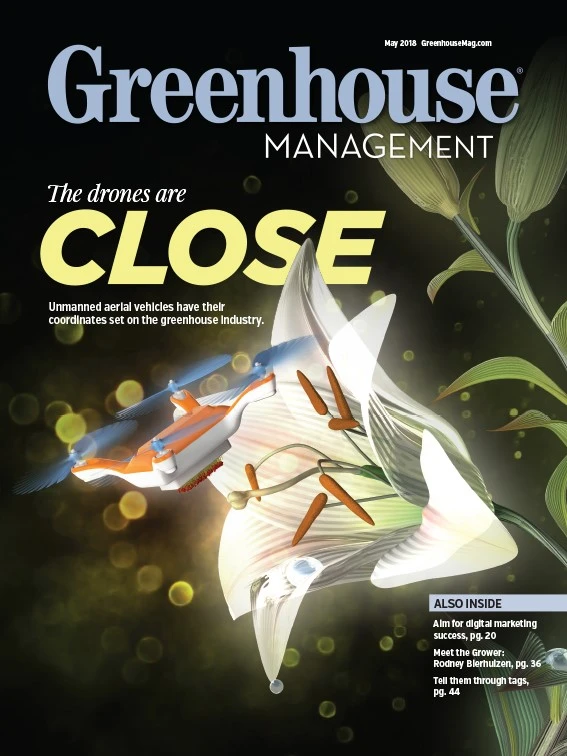
Low-cost growing structures are used by many growers for short-term production space or winter plant protection. These are not usually heated, but sometimes minimal heat is needed to keep the temperature above freezing.
The amount of heat needed can be approximated by the formula HL = A x U x ?T where:
- HL = Heat loss (Btu/hr)
- A = Surface area of structure (sq ft), U = U-value — heat loss factor (Btu/hr – sq ft-°F) — Use 1.25 for single layer glazing, 0.8 for double layer, or 0.7 for double wall polycarbonate.
- ?T = temperature difference between inside and outside (°F) on the coldest night.
The following discusses some of the options that growers must provide heat.
Hot air systems – Compared to water systems, air heating systems have the advantage of being low cost and easy to shut down when heat is no longer needed. Most have a blower that provides some heat distribution. Installing horizontal air flow (HAF) or perforated poly ducting can increase the uniformity of the heat in longer structures. A disadvantage to heated air systems is that very little heat gets down to the root zone in plants placed on the floor. Vented equipment should be selected to exhaust flue gases that may contain sulfur or ethylene. Because these heaters will have limited use, look for used equipment.
Unit heaters – These are available in many sizes to accommodate most protected areas. They are usually supported from the hoops or from a frame that gets them above the plants. The fuel source can be natural gas, propane or fuel oil. High efficiency condensing gas heaters (93 percent) are available but these may have problems with the condensate freezing in cold weather unless they are drained.
Floor furnaces – These furnaces are available in sizes from 50,000 to 500,000 Btu/hr that can be fired with fossil fuels. A model with a blower instead of a fan that is attached to perforated poly ducting works well for under bench heat.
Hot water systems – There are more options with water systems. The advantages include better distribution of heat with the resulting more uniform temperature. The disadvantages include generally more expensive equipment and the system may have to be drained or blown out if it is shut down during freezing weather.

Root zone heat – Locating the distribution system on benches, on the floor or buried underground will provide heat throughout the whole plant area. Heat sources can be low-cost domestic water heaters, in-line instantaneous water heaters or high-efficiency condensing boilers. An additional heat source may be needed on very cold nights as there is limited heat from the root zone. Storing the excess heat from a greenhouse heating system in an insulated heat storage tank during the day and then using this heated water at night may make an economical system.
A biomass-fired outdoor boiler could also provide hot water. A disadvantage is that it requires recharging late in the evening and early in the morning on cold nights. Distribution of heat could be low-output fin radiation, PEX or virgin black poly tubing or an EPDM tubing heat mat.
Heat exchangers – Water to air heat exchangers, available in many outputs, can provide heat distribution if you have a good supply of hot water. They are inexpensive compared to fossil-fired unit heaters. Location is important to get good heat distribution in low or narrow structures. Installing HAF fans can help to distribute the heat.
Low output aluminum fin radiation – This may be a good choice in cold frames or overwintering houses where a limited amount of heat is needed. Depending on the style, these have an output of 50 to 150 Btu/linear foot at 150-degrees °F water temperature. They need to be installed so that they can be drained or blown out if the system is shut down during cold weather.
Temperature control for this heating equipment should be accurate electronic thermostats located in the center of the growing area. If freezing temperature is the main concern, locate the thermostat just above plant height. Be sure that the structure is tight to reduce cold infiltration air. Place some max-min thermometers in the growing area to monitor temperature extremes.

Explore the May 2018 Issue
Check out more from this issue and find your next story to read.
Latest from Greenhouse Management
- Anthura acquires Bromelia assets from Corn. Bak in Netherlands
- Top 10 stories for National Poinsettia Day
- Langendoen Mechanical hosts open house to showcase new greenhouse build
- Conor Foy joins EHR's national sales team
- Pantone announces its 2026 Color of the Year
- Syngenta granted federal registration for Trefinti nematicide/fungicide in ornamental market
- A legacy of influence
- HILA 2025 video highlights: John Gaydos of Proven Winners





